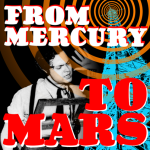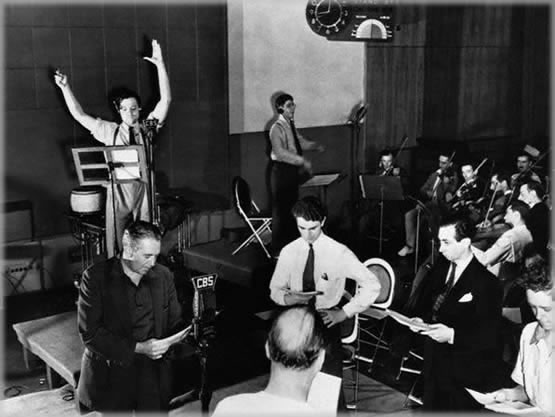From Mercury to Mars: Why Teach War of the Worlds
 I turn down the lights and encourage students to close their eyes or rest their heads on the desks. Then I play the first 20 minutes of The Mercury Theater on the Air 1938 broadcast of War of the Worlds. Sometimes I play it straight through; sometimes I pause it occasionally and ask students what’s happening.
I turn down the lights and encourage students to close their eyes or rest their heads on the desks. Then I play the first 20 minutes of The Mercury Theater on the Air 1938 broadcast of War of the Worlds. Sometimes I play it straight through; sometimes I pause it occasionally and ask students what’s happening.
I ask students to identify the aural and narrative strategies that may have convinced some listeners they were listening to news accounts of an actual invasion in progress. I suggest that people in the 1930s weren’t any more stupid, or naïve, or fearful than we are today. What exactly made the program effective? Through discussion, we identify many of the techniques: the interruption of a dance music performance in the “Park Plaza Hotel” by news bulletins from the “Intercontinental Radio News” service reporting strange events in the sky and the arrival of a meteorite; the cutaway interviews with astronomical experts, such as “Professor Pierson” from Princeton University who insists nothing unusual is happening; the references to official sounding organizations, such as the “Government Meteorological Bureau”; the direct address to the “radio audience” that “we are speaking to you from” a specific location; the announcements of actual broadcast times during the “news bulletins”; actual New Jersey place names such as Trenton and Grover’s Mill; the “on location” reporting by “Carl Phillips, commentator,” who provides “word pictures” for the radio audience; the interview of the “eyewitness,” a “farmer” who doesn’t speak properly into the microphone and repeats himself; and sound effects that include the hubbub of crowds and police sirens, the eerie “scraping noise,” and then the piercing sound and screams, cut off suddenly, leaving dead air. “Ladies and gentlemen,” the announcer breaks in, “due to circumstances beyond our control, we are unable to continue the broadcast from Grover’s Mill. Evidently there is some difficulty with our field transmission.” I usually stop there and ask the students what happened to Carl Phillips. They always know.
 When I use WOTW in my Introduction to Media Studies course, I hope to help students engage with a cultural artifact from the past, sharpen their observational and listening skills, experience aural narrative, and critique the conventions that they usually employ to distinguish fact from fiction. Close listening, I believe, allows students to be specific in their analysis.
When I use WOTW in my Introduction to Media Studies course, I hope to help students engage with a cultural artifact from the past, sharpen their observational and listening skills, experience aural narrative, and critique the conventions that they usually employ to distinguish fact from fiction. Close listening, I believe, allows students to be specific in their analysis.
While I use it to make fairly simple points in the classroom, WOTW can serve a variety of pedagogical aims. It can be used either to illustrate or to challenge theories of the direct effects of mass communication. It can be seen as a symptom of the rise of mass culture, one that subsumes individual rationality, or it can be analyzed as a unique cultural text reflecting a moment of artistic and technological innovation. The few listeners who panicked may demonstrate the manipulability of audiences or support the elite view of “mass” audiences as irrational. The program can be seen as reflecting contemporaneous political currents, such as fears of a Nazi invasion and looming world war, or as an allegory applicable to other historical moments, including the present. It can be analyzed as a key star text for Orson Welles, in the context of his transmedia career, or as an example of collaborative culture-making within the constraints of commercialism.
The WOTW broadcast can be used to explore the problems of text versus context, the complexity of reception, the construction of audiences, the varieties of narrative forms, and the hierarchies of culture. It is also a science fiction narrative, based on a nineteenth-century text, but unfolding in the present tense and constructed from contemporaneous social, scientific, and journalistic discourses.
 Finally, but perhaps most important to those of us who hope for greater attention to audio media, WOTW can be one of the best artifacts for introducing students to the aesthetics of sound media and aural narrative. Its sophistication usually impresses students who claim to be bored by anything old or nonvisual.
Finally, but perhaps most important to those of us who hope for greater attention to audio media, WOTW can be one of the best artifacts for introducing students to the aesthetics of sound media and aural narrative. Its sophistication usually impresses students who claim to be bored by anything old or nonvisual.
All of these approaches–and others–are possible. WOTW is a spectacularly rich historical media artifact that can serve a variety of needs for media educators. But don’t take my word for it; take a few minutes and LISTEN! (If you’re busy, the first 20 minutes will do the trick!)
(Note: Many thanks to the members of the “Teaching Media” Facebook group who contributed their thoughts about teaching WOTW.)
This is Antenna’s second post, and fourth overall, in our ongoing joint venture with Sounding Out!, From Mercury to Mars: Orson Welles on Radio after 75 Years. This continuing series examines Orson Welles and his career in radio, prompted by the upcoming 75th anniversary of Welles’s 1938 “Invasion from Mars” episode and the Mercury Theater series that produced it. Stay tuned for Sounding Out!’s next installment on September 30th.
Miss the first three posts in the series? Click here to read Tom McEnaney’s thoughts on the place of Latin America in Welles’s radio work. Click here to read Eleanor Patterson’s reflections on recorded re-releases of the “War of the Worlds” broadcast. And click here to read Debra Rae Cohen’s thoughts on media-consciousness in Orson Welles’s “Dracula.”



For more ideas for how to use War of the Worlds in the classroom, take a look at the new collection, edited by Kathleen Battles, Joy Elizabeth Hayes, and Wendy Hilton-Morrow: War of the Worlds to Social Media: Mediated Communication in Times of Crisis.
http://www.amazon.com/War-Worlds-Social-Media-Communication/dp/1433118009/ref=sr_1_3?s=books&ie=UTF8&qid=1378171368&sr=1-3&keywords=kathleen+battles+war+of+the+worlds